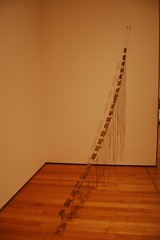Minimalism describes movements in various forms of art and design, especially visual art and music, where the work is stripped down to its most fundamental features. As a specific movement in the arts it is identified with developments in post-World War II Western Art, most strongly with American visual arts in the late 1960s and early 1970s, says Wikipedia.
It is rooted in Modernism, and was a reaction against Abstract Expressionism and a bridge to Postmodern art practices.
The term "minimalist" is often applied to designate anything which is spare or stripped to its essentials. It has also been used to describe the plays of Samuel Beckett, the films of Robert Bresson, the stories of Raymond Carver.
Architect Ludwig Mies van der Rohe adopted the motto "Less is more" to describe his aesthetic tactic of arranging the numerous necessary components of a building to create an impression of extreme simplicity.
Minimalists in the golden era: Piet Mondrian, Constantin Brancusi, Mark Rothko, Eva Hesse. Much of Clyde Connell's work could be called minimalist.
Wednesday, October 22, 2008
Subscribe to:
Post Comments (Atom)





No comments:
Post a Comment